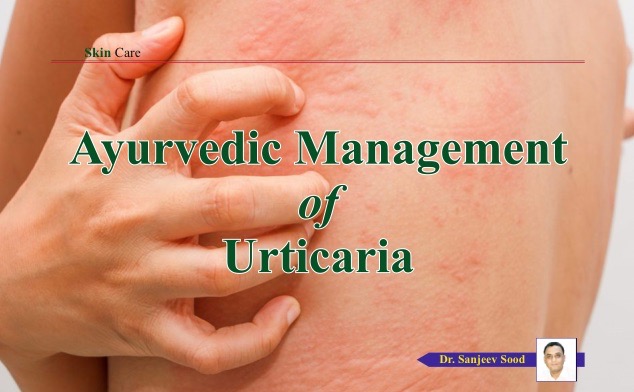Urticaria, commonly known as hives, are red raised itchy welts on the skin. The term urticaria is derived from Latin word urtica which means nettle. Nettle is a perennial plant with botanical name Urtica dioica. It bears stinging hair. When touched, the hair release several chemicals causing irritation. The itch in urticaria can be mild or tense, of long or short duration.
Urticaria, commonly known as hives, are red raised itchy welts on the skin. The term urticaria is derived from Latin word urtica which means nettle. Nettle is a perennial plant with botanical name Urtica dioica. It bears stinging hair. When touched, the hair release several chemicals causing irritation. The itch in urticaria can be mild or tense, of long or short duration. The shape of lesion maybe round on linear lines. The size may be from small pin head to a large serving plate. It may occur in clusters which tend to appear and clear in a few hours. Some people may have single flare up in their lifetime and others may have recurrence .There are a number of trigger factors causing this condition like cold water, pressure ,medical conditions or drugs. The risk factors include hay fever and asthma. Urticaria that lasts less than six weeks is acute and that which remains for more than six weeks is chronic . In chronic cases, the cause is difficult to find and the person may have hives every day for months or years.
These triggers result in the release of inflammatory chemicals including histamines from cutaneous mast cells which result in fluid leakage from superficial blood vessels in the skin. Diagnosis is typically based on the appearance. Patch test maybe helpful.
In modern science, there is vast use of antihistamines, steroids, leukotriene receptor antagonists and immuno suppressives to overcome the clinical features and control the situation. They have been proven very effective but good for acute cases only. To deal with chronic condition, an alternative approach is required as steroids have their own hazards if used for long duration.
In Ayurveda, the disease is known as sheetpitta. In it, the aggravated doshas relocate in the skin and vitiate the blood, causing raised rash with intense itching. Ayurveda quotes that intake of excess salt, exposure to cold air and contact with poisonous insects, is responsible for the onset of disease. It advocates different practices to deal with this annoying disease. These include panchkaram in which sneha paan, vaman and virechan karam prove to be very effective in treating the ailment. Use of herbs like haldi, neem, shirish, gambhari, manjishtha and triphala is also very beneficial .
Home remedies
• Mud bath
• Oatmeal bath
• Mustard oil massage
• Use of neem leaves paste
• Intake of triphala decoction
• Tulsi leaves application.
Classical formulations
Haridra Khand, Arogyavardhini Vati, Gandhak Rasayan, Sheetpitta Bhanjan Ras, Kaishore Guggul, Eladi Vati, Mahatiktam Kashaya and Patola katurohini Kashaya.
Principal,
Dayanand Ayurvedic College, Jalandhar.
Mob.: 9814004142 drsanjeevsood@gmail.com







 Dec 2024
Dec 2024
 May 2024
May 2024
 September 2022
September 2022
 April 2022
April 2022
 October 2020
October 2020
 Jan 2020
Jan 2020
 June 2019
June 2019
 January-February 2019
January-February 2019
 Augest-September
Augest-September
 April 2018
April 2018
 November 2017
November 2017
 June 2017
June 2017
 November 2016
November 2016
 September 2015
September 2015
 March 2015
March 2015
 July 2014
July 2014
 January 2014
January 2014
 July2013
July2013
 March 2013
March 2013
 May 2012
May 2012
 May 2011
May 2011
 Sep 2010
Sep 2010
 Jun 2010
Jun 2010
 Feb 2010
Feb 2010
 December 2009
December 2009
 August 2009
August 2009
 June 2009
June 2009
 Feb 2009
Feb 2009
 December 2008
December 2008
 October 2008
October 2008
 March 2008
March 2008
 July 2008
July 2008
 May 2008
May 2008